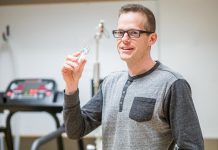August 2003 - An ambitious and exhaustive genetic study, led by investigators at the Joslin Diabetes Center and the Children's Hospital Boston Informatics Program, has pinpointed a group of genes that are involved in type 2 diabetes and shows that the activity of these genes changes even before overt diabetes develops. The study appears in a July 2003 edition of the Proceedings of the National Academy of Sciences (1).
The investigators at Joslin, led by Dr. Mary-Elizabeth Patti, an endocrinologist and scientist and director of the Genomics Laboratory at Joslin, wanted to identify genes that might be altered in people with diabetes and in those at high risk for the development of diabetes. To do this, they used a microarray � a small slide dotted with small pieces of DNA � to simultaneously measure the activity of over 7,000 genes in muscle tissue from Mexican-Americans, an ethnic group with a very high risk for diabetes. They compared three groups: subjects with diabetes, healthy subjects without diabetes, and high-risk subjects with "prediabetes" (diabetes in family members).
"Knowing which genes are turned on or off in people before they develop diabetes is a key piece of information needed to solve the puzzle of diabetes, and to identify new ways to treat and prevent this devastating disease," Dr. Patti explains.
Two genes, PCG1-alpha and PCG1-beta, showed reduced activity (also known as expression) not only in the people with diabetes, but also in those with prediabetes. This decreased activity appeared to lead to reduced activity of a larger group of genes involved in the metabolism of fats and carbohydrates. These genes code for proteins in the mitochondria, cell structures that play a critical role in energy metabolism. Reduced activity or expression of these genes may tip the scales to insulin resistance, or an inability of the body's cells to use insulin properly -- the first metabolic defect on the road to type 2 diabetes.
The investigators used bioinformatics techniques to hone in on the relevant genes from the initial 7,000 measured, explains co-investigator Dr. Atul Butte of the Children's Hospital Informatics Program (CHIP). The CHIP team also applied statistical techniques to adjust for various technical challenges, such as changes in scanner and chip technology during the course of the study.
Continue Reading Below ↓↓↓
The investigators first compared patterns of gene expression in people with diabetes versus the nondiabetics, and found that 187 genes were expressed differently between the two groups. Next, they compared the nondiabetics with the prediabetics, and found differences in expression for 166 genes. Further analysis found that 55 genes showed up in both comparisons � their activity was altered in both the diabetics and the prediabetics.
"That 55 is a valuable list of changes that are going on in the prediabetics, and should be studied further," says Dr. Butte. "What's interesting is that we can see these changes in gene expression even before the diagnosis of diabetes is made. This tells us that the process of getting to diabetes may be a continuum."
The hardest part of the study, which took three years to complete, was to make biological sense of the data on gene activity, notes Dr. Butte. "Even after you have a list of genes that are different between those with diabetes and nondiabetics, what does that pattern mean?" he asks. "In the end, what you're dealing with isn't genes, it's explanation." Dr. Butte's goal is to improve bioinformatics tools for diabetes research so that they incorporate what's known biologically about diabetes. "In this study, the microarrays were crucial, but you can't analyze these arrays without the context of the biology," he says. "That reasoning can't yet be done by computers."
Through repeated examination of the list of genes, integration of medical and scientific information, and educated guesses, Dr. Patti came to the realization that many of the genes altered in diabetes encode for proteins in the mitochondria, and that the majority is regulated by another gene known as NRF-1. That gave the clue to look at PCG-1 alpha and beta, genes that work with NRF-1 and may function as master controllers for many metabolic genes important in insulin resistance and diabetes.
"This information is quite exciting, since it provides direction for additional critical research to test new hypotheses about the role of these genes in development of diabetes," says Dr. Patti. "More importantly, if we can identify people at high risk for diabetes and learn to prevent these changes from taking place, we may be able to find better methods for both treatment and prevention of diabetes."
Because a number of genes on the list are known to be affected by exercise and obesity, the researchers propose that factors like inactivity and overeating may increase diabetes risk in genetically susceptible people by altering the expression of metabolic genes. Adds Dr. Patti, "Until we solve the final puzzle related to these genes, the good news is that healthy eating, exercise, and some medications are effective tools to both prevent and control diabetes."
The research was supported by the National Institutes of Health, the Endocrine Fellows Foundation, the Lawson Wilkins Pediatric Endocrinology Society, the Iacocca Foundation, the American Diabetes Association, and Harvard Medical School.
(1) Patti ME, Butte AJ, et al. Coordinated reduction of genes of oxidative metabolism in humans with insulin resistance and diabetes: Potential role of PGC1 and NRF1. Proc Natl Acad Sci 2003 July 8, 100:8466-71.
Source: Joslin Diabetes Center










